Last of the Auto Unions?
The Typ 650 or 'Sokol': To Moscow and back
Authors
- Jeroen Bruintjes, assisted by Holger Merten
Date
- December 24, 2002
Related articles
- The early Auto-Unions - From P-Wagen to A-type, by Leif Snellman
- Auto Union - The history of the AU racing department, a triptych of essays on the Saxonian marque's racing exploits, by Holger Merten
- Part 1: The small workshop that created motor racing history (1931-1935)
- Part 2: The comeback years (1936-1939)
- Part 3: The scars of war (1939 and beyond)
- Auto Union Type E - The stillborn 1.5-litre car: why it (almost) did exist, by Jeroen Bruintjes
- Sokol 650 - Post-war Auto Union in disguise or a socialist F2 effort? Secrets of Tom Wheatcroft's "Type E" unveiled, by Jeroen Bruintjes/Holger Merten
- Part 2: Through the iron curtain
- Part 3: It's an Awtowelo!
- Part 4: Awtowelo debuts at Goodwood
Who?Fritz Trägner What?Entwicklungswerk Chemnitz/Auto Union Typ 650, or 'Sokol' Where?Possibly Glauchau Autobahn When?Probably April 1952 |
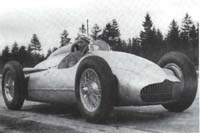 |
Why?
Answering to the wish of Josef Stalin’s son Vasiliy, who dreamed of a succesful Soviet race team, a team of pre-war Auto Union employees designed and built two 12-cylinder racing cars. Using Auto Union parts and design practices, these cars were built for the normally aspirated Formula 2 class. Both cars even made it to Moscow and back, but engine flaws, a new Formula and the imprisonment of Vasiliy Stalin kept them from ever reaching their true potential. Today, one car survives in the British Donington museum, the remains of its brother in the depot of a German museum.
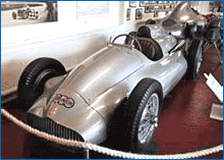 Spotting faults in other people’s accomplishments is easy. For example, take the silver racing car that sits in the collection of the Donington museum. Boldly on display as an ‘Auto Union Typ E’, it goes where no Auto Union has gone before. ‘Cos it ain’t! But being the true gentlemen we are, we go beyond criticizing and try to offer an alternative explanation of this car’s origins. Or do we? Poor us: debunking this story proved to be remarkably difficult. Not because it is uncharted territory – its unknown history is merely an example of the lack of communication between British and German motorsport journalism. No, because this story is so breathtakingly exciting and complex, that a quick & dirty analysis is impossible.
Spotting faults in other people’s accomplishments is easy. For example, take the silver racing car that sits in the collection of the Donington museum. Boldly on display as an ‘Auto Union Typ E’, it goes where no Auto Union has gone before. ‘Cos it ain’t! But being the true gentlemen we are, we go beyond criticizing and try to offer an alternative explanation of this car’s origins. Or do we? Poor us: debunking this story proved to be remarkably difficult. Not because it is uncharted territory – its unknown history is merely an example of the lack of communication between British and German motorsport journalism. No, because this story is so breathtakingly exciting and complex, that a quick & dirty analysis is impossible.
It all started out when... see! Even forming a suitable beginning of the story is difficult. So we’ll just make an arbitrary decision and start in early 1945. One beautiful April day, a German officer swiftly climbed the stairs of St Mary’s Cathedral in Zwickau. Panting, he stuck a white flag out of the clock tower’s windows. With that the man signalled the unconditional surrender to the onstorming US troops and protected his town from further destruction. The Americans swooped through the city, where they established a makeshift town government before marching on eastwards. The war was over for Zwickau, and with that for the Auto Union Rennabteilung. From now on, the world and motorsport would never be the same again.
The American offensive finally ended a few miles out of Chemnitz, where Auto Union’s corporate headquarters were located. Coming from the other side of the world, the Red Army took Chemnitz on the 8th of May. US occupation of eastern Germany would last until July. Ironically, the Auto Union buildings lay almost on the edge of the no man’s land between the two allied forces. As for the racing cars themselves: they lay hidden in some mines near Zwickau. The whole thing was there for the US troops to take away, if they had been interested. They weren’t and in July they withdrew behind the boundaries to which western allies had agreed with Joseph Stalin.
The son
As it happens, this Mr. Stalin had a son, Vasiliy. A pilot and a colonel in the Red Army, Vasiliy happened to be amongst the troops marching over eastern Germany. He was a man fascinated by speed and loved fast airplanes and motorcycles. Being the son of a powerful Soviet leader helped a great deal, since it allowed him to engage in decadent pleasures, like buying and driving fast cars. Imagine Vasiliy’s delight when he learned of the infamous Auto Unions being discovered by the Red Army. On his request, the Russian transportation corps had no problem coming up with a train. And on a grey morning this train pulled out of Zwickau, carrying the Auto Unions to Moscow.
You see, Vasiliy Stalin had a wish. He really would like to see Russian racing cars compete and win in races with western opponents. As motorsport in Europe slowly gathered pace again, some opportunities presented themselves. For example, a succesful Soviet racing team might be possible in the Formula 2 that had started out in 1948. Of course, Vasiliy had all the technology he needed, with the captured Auto Unions among the world’s fastest cars. But this presented some unique problems too. First, the pre-war beasts didn’t fit into the 2-litre category. Second, they were Nazi-German developments. A proud Soviet driver in an Auto Union, with the red star being the only Russian thing on it? Imagine the smirks on the faces of those capitalist teams!
Rescue came from within, out of a sophisticated form of knowledge loot that the Soviets had started. By June 1946 they had resurrected the Auto Union R&D department in Chemnitz. It operated directly under Soviet control and structured Auto Union’s research results and corporate skills, to be exported into Russia. Around 120 people were working here and the engineers amongst them were quite valuable to the Russians. Half of them developed new cars for the Eastern Occupation Zone, after 1949 known as the German Democratic Republic, while the other half was engaged in projects for Russia. The Soviets went to great lenghts to keep them happy, using up all army privileges to supply good food, housing, clothing, materials, etcetera. Somewhere, sometime, the Soviet personnel controlling this Automobiltechnisches Büro (ATB) and Vasiliy Stalin must have joined forces. Because around 1947, the ATB saw a separate team with a new task: to use pre-war Auto Union knowledge and materials to develop one or more racing cars suitable for Formula 2. The project was baptised the Typ 650 [but I have no idea why, jb].
The team
If you step back and take a look, it is remarkable just how similar the pre-war and post-war efforts were organised. With the start of project 650 the ATB was renamed to Entwicklungswerk Chemnitz. A new Soviet director, V.G. Myshkin, became head of racing developments. Myshkin appears to have been in the same position as Adolf Hühnlein was in the 1930s: a director and decision maker, a liaison between a government seeking propaganda and a racing department looking for technical challenges. He must have had extensive support of the Soviet authorities and the Red Army, since there was no such thing as post-war shortage in the Entwicklungswerk. It appears that Vasiliy Stalin was to get the cars he wished, regardless of cost. Brand-new Pirelli tyres came in from Italy, an ample supply of fuel was mixed and delivered - everything was possible. It must have been quite a luxury for the team. As for them, the most important members were:
- Walter Träger, former constructor at Auto Union: engine development
- Adolf Hahn: gearbox and drivetrain
- Lange and Pietzsch: chassis
- Otto Seidan: overall design
- Kordewahn: project leader and bodywork design.
The design
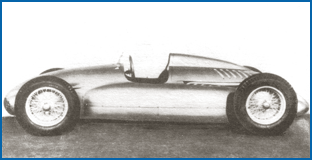 Just how much Auto Union went into the Typ 650 is unknown. But it seems that pre-war designs have at least served as an inspiration, if not as a blueprint. Seidan came up with a design that shows a startling resemblance to the Auto Union Typ D. A model car was made, with 12 exhausts located in the same fashion as the D. On the actual car, these exhausts combine into two manifolds leading backwards. Walter Träger, who co-designed the Typ D engine in 1938, came up with a new 1992cc V12 with four overhead camshafts.
Just how much Auto Union went into the Typ 650 is unknown. But it seems that pre-war designs have at least served as an inspiration, if not as a blueprint. Seidan came up with a design that shows a startling resemblance to the Auto Union Typ D. A model car was made, with 12 exhausts located in the same fashion as the D. On the actual car, these exhausts combine into two manifolds leading backwards. Walter Träger, who co-designed the Typ D engine in 1938, came up with a new 1992cc V12 with four overhead camshafts.
Compressor manifolds?
However, this engine hadn't been the Soviets' first choice. When founding the project right after the war, their initial goal was to revive the Typ E project and use this car for racing purposes. Plans changed quickly when news on the upcoming formula changes filtered through in October 1947. Also, several Typ E designs must have been missing, as did some of the parts that had already been finished before and during the war. Faced with these challenges, the team came up with a new BMW-style rear axle and a different gearbox layout, followed by a 2-litre engine.
Chronology suggests that the engine was a development of the Typ E engine, which is what Kirchberg claims in his book. Also, he refers to the problems of the inlet manifolds, originally meant for use in a supercharger setup. Other sources deny these ties to pre-war Auto Union designs, claiming that the distance between cylinders, the stroke and bore and the V-angle are different. This also suggests that it is not a smaller Typ D design, but a different beast altogether. Still, the Typ 650s are a little strange and appear to have been designed for a supercharger instead of a normally aspirated carburettor configuration. Each Solex carburettor feeds three cylinders, but the feed of the third cylinder is inefficient and could only be equalised by boost pressure. A clue here might lie in the Russian sources. They refer to a ‘ramjet’ Solex carburettor setup. It is possible that the design originally was aimed at optimal performance at higher speeds, where the air being pushed into the engine compartment would create pressure. Like the powerdomes on American hotrods, this forces more oxygen into the carburettors and creates boost in the manifolds. Besides, choosing a less-than-efficient manifold in high-power cars is not as unusual as it seems. The fuel-injected inline engines of 1970s and 1980s BMWs, Audis and Mercedes show the same phenomenon, even in the faster models.
Chassis
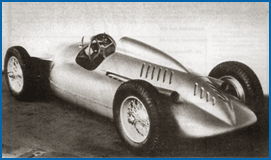 The chassis is largely identical to the Typ D and shows many parts from this car. For example, the front axle is nearly identical. It may be that leftover pre-war parts were used. Its rear axle however differs from Auto Union’s designs. Here, the designers opted for a different de Dion type, maybe because of the arrangement of the drivetrain. Where Auto Unions used to place the transmission behind the rear axle, the Typ 650 had it between the engine and the axle. This design of the torsion bar and the De Dion rear axle later also appeared in the EMW racecars.
The chassis is largely identical to the Typ D and shows many parts from this car. For example, the front axle is nearly identical. It may be that leftover pre-war parts were used. Its rear axle however differs from Auto Union’s designs. Here, the designers opted for a different de Dion type, maybe because of the arrangement of the drivetrain. Where Auto Unions used to place the transmission behind the rear axle, the Typ 650 had it between the engine and the axle. This design of the torsion bar and the De Dion rear axle later also appeared in the EMW racecars.
Specifications
V12, 65 degrees (D and E: 60 degrees)
Displacement: 1992 cc (D: 2990 cc, E 1481,8 cc)
Bore x stroke: 62 x 55 (D: 65 x 75, E 53 x 56)
Four overhead camshafts (D and E: three ohc)
Four Solex downdraft carburettors
Estimated power output: 150 bhp (D: 485 bhp, E: 260-327 bhp)
Weight 632 kg
LxWxH 3800 x 1500x 1250 mm
Track width 1240 mm (D: 1143 mm)
Wheelbase 2250 mm (D: 2743 mm, E: 2500 mm)
Five-speed gearbox (D: five-speed, E: six-speed)
Somewhere in 1951 or 1952, former AU motorcyclist Fritz Trägner took the first test runs in front of the Chemnitz buildings. Later, the team chose an autobahn for testing, perhaps on the stretch of A4 at Glauchau, near Chemnitz, which was already a familiar testing ground for pre-war Auto Unions. The car performed quite well and gradually reached faster speeds up to 180 km/h. Barth and Melkus appear briefly amongst those drivers considered to race this car, but it seems that they were deemed too young and inexperienced.
Moscow
By April 1952, two Typ 650s were completed. Vasiliy Stalin, who now ranked Major General in the Moscow air force regiment, ordered a plane to Germany to collect both cars. They arrived in Moscow on April 8th. Reassembly and tuning was to take place immediately, but the mechanics failed hopelessly to get the cars running. They were unfamiliar with the Solex ramjet carburettors, and the fact that these cars required a complex fuel mixture didn’t help too. It may even be that the Soviets did not have such fuel. Anyway, they came up with an easy fix: a couple of Opel carburettors. With those the engines started, but lacked power.
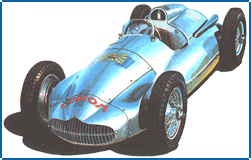 Several test runs showed no satisfactory results. Apparently, one took place on a highway in April 1952, although it’s not clear whether this was in the Soviet Union or in early April in Germany. The cars did however appear in a championship race near Moscow, on June 30th 1952, raced by CSKA pilots Pavel Baranov and Vasiliy Kuznetzov. Both machines broke down, again with carburettor problems. It is around this time that the cars earned their name ‘Sokol’. It is the Russian word for ‘Falcon’, which was a propaganda nickname for pilots in those days. ‘Stalin falcons’ were frequently used buzzwords in newspapers and radio news bulletins. Vasiliy Stalin wanted his pilots to drive the Typ 650, hence the name. Sadly, no such thing happened. Stalin became annoyed by the Sokols’ bad performance and by his mechanics’ failure. So he decided to send them back to Germany and order the Chemnitz team to have a look at the car. After all, the test results there had been far more promising. Again, his troops packed the two cars in an airplane.
Several test runs showed no satisfactory results. Apparently, one took place on a highway in April 1952, although it’s not clear whether this was in the Soviet Union or in early April in Germany. The cars did however appear in a championship race near Moscow, on June 30th 1952, raced by CSKA pilots Pavel Baranov and Vasiliy Kuznetzov. Both machines broke down, again with carburettor problems. It is around this time that the cars earned their name ‘Sokol’. It is the Russian word for ‘Falcon’, which was a propaganda nickname for pilots in those days. ‘Stalin falcons’ were frequently used buzzwords in newspapers and radio news bulletins. Vasiliy Stalin wanted his pilots to drive the Typ 650, hence the name. Sadly, no such thing happened. Stalin became annoyed by the Sokols’ bad performance and by his mechanics’ failure. So he decided to send them back to Germany and order the Chemnitz team to have a look at the car. After all, the test results there had been far more promising. Again, his troops packed the two cars in an airplane.
Click here to continue to part 2
Sources
- Doug Nye, Classic & Sportscar, December 1985
- Autonet.ru
- Stefan Knittel: Auto Union Grand Prix Wagen, Schrader & Partner, München 1980
- Peter Kirchberg: Grand-Prix-Report Auto Union 1934-1939, VEB Verlag für Verkehrswesen, Berlin 1982
- Peter Vann: Neusilber, Motorbuch Verlag Stuttgart, 2001
- The Atlas F1 Nostalgia Forum
- Bestand der Auto Union AG, Sächsisches Staatsarchiv Chemnitz
